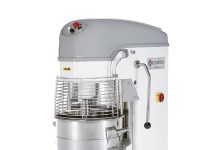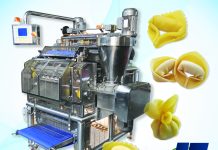
by Clara Biancardi
In the view of a constant development, in its headquarters in Riese Pio X (Tv) Pasta Zara has a new automated warehouse, capable of storing approximately 25,000 pallets of finished product. And just over a month ago a new automated warehouse has been built that will serve the factory in Muggia (Ts), capable of storing approximately 66,000 pallets. The partner of this great commitment is Lyto’s, present on the market for almost 50 years and totally focused on this type of structural achievements.
Automated warehouse: the driving force between production and sale

The ability to maximize space (always more expensive and less available) to store materials in height – we are close to the milestone of 40 m-is the main reason that drives a company to invest in automated warehouses. The second reason is the need to always have at one’s disposal a wide range of products, approaching production needs (producing larger lots) and sales request (increasingly wide range). Thus, automated warehouses are the driving force between production and sales. These are the two most important reasons, but not the only advantages, and at this point know-how comes into play. Working 24 hours a day and always at the same speed (high), without suffering for the burden of night work like humans do; the ability to optimize the storage logic according to the priority of outstanding orders; 100% operations control; reduction of time required for the management of single load units; no “human” errors in shipping management. This is just a part of the advantages, not to mention all aspects related to safety (absence of continuously moving trolleys in areas with staff presence) and the change of mindset that automated management demands to all involved operators.
Stable structure over time
For Pasta Zara, Lyto’s has supplied shelving and the cover panels of the building as well as the structural design of the warehouse’s foundations, including of course, its flooring. One of its winning technical solutions is shelving that isn’t placed directly on a concrete base but on HEA beams that are incorporated in it. The first advantage is absolute flatness of shelving support base, free from flooring tolerances. The second advantage is that in order to anchor the shelving uprights there is no need to drill the floor, causing reinforcement weakening. As a result, total and prolonged stability of shelving support base over time. Lyto’s designs and develops in-house the entire structure, controlling the whole process of design development, in order to ensure total control of every step. In this specific case, the solution is a double depth pallet rack, single carrier, pallet supports along the entire length. C-profiles are not drilled, therefore they are high-strength (each hole represents weakening of the resistant section), and pre- assembled during the production cycle, therefore with total control of welds (certificated). All pre-assembled structures facilitate and speed up the assembly of the structure at the building site. The fastening of the horizontal beams through friction coupling (Lyto’s patent) with controlled tightening torque, offers the advantage of total free design. Concerning the height of load cells, there is no need to drill the normal perforated profiles, which allows maximizing the available volume. C-profiles fastened to the horizontal beams allow supporting the pallets throughout their length, thus preventing their bending under load, whatever the quality of wooden pallets. Moreover they allow greater mounting light to automate forklifts, eliminating the risk of the forks’ bumping against the shelving.

Technology and attention to the client
The above-listed advantages are just a few of those obtainable by Lyto’s shelving, a company that produces automated warehouses for manufacturers of various sectors worldwide. Besides its cooperation with all pasta factories in Italy, the company has created projects ranging from food to beverage, from mechanics to chemistry up to the pharmaceutical sector. Its projects are present on all continents, thanks to its know-how and attention to customer needs. The latest example is undoubtedly its collaboration with Pasta Zara, where the success of the project has been favored by this collaboration, which has effectively allowed the realization of expectations/needs of the end user.



